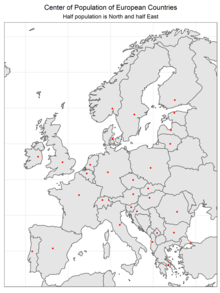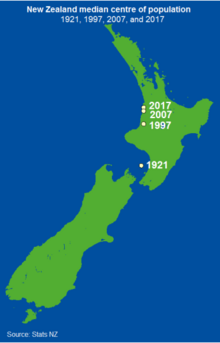Center of population

Indemographics,thecenter of population(orpopulation center) of a region is a geographical point that describes a centerpoint of the region's population. There are several ways of defining such a "center point", leading to different geographical locations; these are often confused.[1]
Definitions[edit]
Three commonly used (but different) center points are:
- themeancenter,also known as thecentroidorcenter of gravity;
- themediancenter,which is the intersection of the medianlongitudeand medianlatitude;
- thegeometric median,also known asWeber point,Fermat–Weber point,orpoint of minimum aggregate travel.
A further complication is caused by the curved shape of the Earth. Different center points are obtained depending on whether the center is computed in three-dimensional space, or restricted to the curved surface, or computed using a flatmap projection.
Mean center[edit]
The mean center, or centroid, is the point on which a rigid, weightless map would balance perfectly, if the population members are represented as points of equal mass.
Mathematically, the centroid is the point to which the population has the smallest possiblesum of squared distances.It is easily found by taking the arithmetic mean of each coordinate. If defined in the three-dimensional space, the centroid of points on the Earth's surface is actually inside the Earth. This point could then be projected back to the surface. Alternatively, one could define the centroid directly on a flat map projection; this is, for example, the definition that theUS Census Bureauuses.
Contrary to a common misconception, the centroid doesnotminimize the average distance to the population. That property belongs to the geometric median.
Median center[edit]
The median center is the intersection of two perpendicular lines, each of which divides the population into two equal halves.[2]Typically these two lines are chosen to be aparallel(a line oflatitude) and ameridian(a line oflongitude). In that case, this center is easily found by taking separately themediansof the population's latitude and longitude coordinates.John Tukeycalled this thecross median.[3]
Geometric median[edit]
The geometric median is the point to which the population has the smallest possiblesum of distances(or equivalently, the smallestaverage distance). Because of this property, it is also known as thepoint of minimum aggregate travel.Unfortunately, there is no directclosed-form expressionfor the geometric median; it is typically computed usingiterative methods.[citation needed]
Determination[edit]
In practical computation, decisions are also made on the granularity (coarseness) of the population data, depending on population density patterns or other factors. For instance, the center of population of all the cities in a country may be different from the center of population of all the states (or provinces, or other subdivisions) in the same country. Different methods may yield different results.
Practical uses for finding the center of population include locating possible sites forforward capitals,such asBrasília,AstanaorAustin,and, along the same lines, to make tax collection easier. Practical selection of a new site for a capital is a complex problem that depends also on population density patterns and transportation networks.
World[edit]
It is important to use a method that does not depend on a two-dimensional projection when dealing with the entire world. In a study from theInstitut national d'études démographiques,[4]the solution methodology deals only with the globe. As a result, the answer is independent of whichmap projectionis used or where it is centered. As described above, the exact location of the center of population will depend on both the granularity of the population data used, and the distance metric. Withgeodesicdistances as the metric, and a granularity of 1,000 kilometers (600 mi), meaning that two population centers within 1000 km of each other are treated as part of a larger common population center of intermediate location, the world's center of population is found to lie "at the crossroads between China, India, Pakistan and Tajikistan" with an average distance of 5,200 kilometers (3,200 mi) to all humans.[4]The data used in the reference support this result to aprecisionof only a few hundred kilometers, hence the exact location is not known.
Another analysis, using city-level population data, found that the world's center of population is close toAlmaty,Kazakhstan.[5]
By country[edit]
Australia[edit]
Australia's population centroid is in centralNew South Wales.By 1996, it had moved only a little to the north-west since 1911.[6]It moved only 1.4 km North in 2022 from the previous year.[7]
Canada[edit]
In Canada, a 1986 study placed the point of minimum aggregate travel just north ofTorontoin the city ofRichmond Hill,and moving westward at a rate of approximately 2 metres per day.[8]
China[edit]
China's population centroid has wandered within southernHenanfrom 1952 to 2005. Incidentally, the two end point dates are remarkably close to each other.[9]China also plots its economic centroid or center of economy/GDP, which has also wandered, and is generally located at the eastern Henan borders.
Estonia[edit]

The center of population of Estonia was on the northwestern shore ofLake Võrtsjärvin 1913 and moved an average of 6 km northwest with every decade until the 1970s. The higher immigration rates during the lateSoviet occupationto mostlyTallinnandNortheastern Estoniaresulted the center of population moving faster towards north and continuing urbanization has seen it move northwest towards Tallinn since the 1990s. The center of population according to the 2011 census was inJüri,just 6 km southeast from the border of Tallinn.[10]
Finland[edit]
In Finland, the point of minimum aggregate travel is located in the former municipality ofHauho.[11]It is moving slightly to the south-west-west every year because people are moving out of the peripheral areas of northern and eastern Finland.
Germany[edit]
In Germany, the centroid of the population is located inSpangenberg,Hesse,close toKassel.[12]
Great Britain[edit]
The centre of population in Great Britain did not move significantly in the 20th century. In 1901, it was inRodsley,Derbyshire and in 1911 inLongford.In 1971 it was atNewhall,Swadlincote,South Derbyshire and in 2000, it was inAppleby Parva,Leicestershire.[13][14]Using the 2011 census the population center can be calculated atSnarestone,Swadlincote.[15]
Ireland[edit]
The center of population of the entireisland of Irelandis located nearKilcock,County Kildare.This is significantly further east than theGeographical centre of Ireland,reflecting the disproportionately large cities of the east of the island (BelfastandDublin).[16]The center of population of theRepublic of Irelandis located southwest ofEdenderry,County Offaly.[17]
Japan[edit]
The centroid of population of Japan is inGifu Prefecture,almost directly north ofNagoyacity, and has been moving east-southeast for the past few decades.[18]Since 2010, the only large regions in Japan with significant population growth have been inGreater TokyoandOkinawa Prefecture.
New Zealand[edit]

In June 2008, New Zealand's median center of population was located nearTaharoa,around 100 km (65 mi) southwest ofHamiltonon theNorth Island's west coast.[19]In 1900 it was nearNelsonand has been moving steadily north (towardsAuckland,the country's most populous city) ever since.[20]
Sweden[edit]
Thedemographical center of Sweden(using the median center definition) isHjortkvarninHallsberg Municipality,Örebrocounty. Between the 1989 and 2007 census the point moved a few kilometres to the south, due to a decreasing population in northern Sweden and immigration to the south.[21]
Russia[edit]
The center of population in the Russian Federation is calculated by A. K. Gogolev to be at56°34′N53°30′E/ 56.567°N 53.500°E,42 km (26 mi) south ofIzhevsk.[22]
Taiwan[edit]
The center of population of Taiwan is located inHeping District, Taichung.[23]
United States[edit]
The mean center of the United States population (using the centroid definition) has been calculated for eachU.S. Censussince 1790. Over the last two centuries, it has progressed westward and, since 1930, southwesterly, reflecting population drift. For example, in 2010, the mean center was located nearPlato, Missouri,in the south-central part of the state, whereas, in 1790, it was inKent County, Maryland,47 miles (76 km) east-northeast of the future federal capital, Washington, D.C.
See also[edit]
References[edit]
- ^Kumler, Mark P.; Goodchild, Michael F. (1992). "The population center of Canada – Just north of Toronto?!?". In Janelle, Donald G. (ed.).Geographical snapshots of North America: commemorating the 27th Congress of the International Geographical Union and Assembly.pp. 275–279.
- ^"Centers of Population Computation for the United States, 1950-2010"(PDF).Washington, DC: Geography Division, U.S. Census Bureau. March 2011.
- ^Tukey, John (1977).Exploratory Data Analysis.Addison-Wesley. p.668.ISBN9780201076165.
- ^abClaude Grasland and Malika Madelin (May 2001)."The unequal distribution of population and wealth in the world"(PDF).Population et SociétéS.368.Institut national d'études démographiques: 1–4.ISSN0184-7783.
- ^"Center of World Population".City Extremes.2017.Retrieved21 August2017.
- ^"Figure 15: Shifts in the Australian Population Centroid*, 1911–1996".Parliament of AustraliaParliamentary Library.Archived fromthe originalon 19 August 2000.Retrieved7 January2009.
- ^"Regional population".Australian Bureau of Statistics.20 April 2023.Retrieved20 April2023.
- ^"The Population Center of Canada – Just North of Toronto?!?"(PDF).Retrieved21 April2012.
- ^http://sourcedb.igsnrr.cas.cn/zw/lw/201007/P020100706529106697457.pdf[bare URL PDF]
- ^Haav, Mihkel (2010) - "Eesti dünaamika 1913-1999"
- ^Uusirauma.fi[permanent dead link]Kaupunkilehti Uusi Rauma 03.08.2009 Päivän kysymys? Missä Rauman keskipiste?(in Finnish)
- ^Dradio.deArchived24 October 2007 at theWayback Machine(in German)
- ^"News Item".University of Leeds.Archived fromthe originalon 3 October 2006.Retrieved25 November2007.
- ^"Population Centre".Appleby Magna & Appleby Parva.Archived fromthe originalon 23 November 2007.Retrieved25 November2007.
- ^"Archived copy"(PDF).Archived fromthe original(PDF)on 23 July 2021.Retrieved15 March2020.
{{cite web}}:CS1 maint: archived copy as title (link) - ^"Population Centre of the island of Ireland [2100x2000] [OC]".
- ^"Population Centre of Ireland".
- ^"Our Country's Center of Population ( ta が quốc の dân cư trọng tâm )".Stat.go.jp.Retrieved21 April2012.
- ^"Subnational Population Estimates: At 30 June 2008 -- Commentary".Statistics New Zealand.Retrieved11 November2014.
- ^"Bridget Williams Books".
- ^"Sweden's demographic centre, SCB.se, 2008-03-18".Scb.se. 18 March 2008. Archived fromthe originalon 29 March 2012.Retrieved21 April2012.
- ^Сайт "Встарь, или Как жили люди"
- ^"Re: [ dân cư địa lý ] Đài Loan dân cư trọng tâm phân bố".
Sources[edit]
- Bellone F. and Cunningham R. (1993). "All Roads Lead to... Laxton, Digby and Longford." Statistics Canada 1991 Census Short Articles Series.
